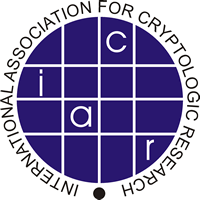
eprint.iacr.org/2024/757
Preview meta tags from the eprint.iacr.org website.
Linked Hostnames
5- 27 links toeprint.iacr.org
- 6 links toorcid.org
- 1 link tocreativecommons.org
- 1 link toia.cr
- 1 link toiacr.org
Thumbnail

Search Engine Appearance
Formal Definition and Verification for Combined Random Fault and Random Probing Security
In our highly digitalized world, an adversary is not constrained to purely digital attacks but can monitor or influence the physical execution environment of a target computing device. Such side-channel or fault-injection analysis poses a significant threat to otherwise secure cryptographic implementations. Hence, it is important to consider additional adversarial capabilities when analyzing the security of cryptographic implementations besides the default black-box model. For side-channel analysis, this is done by providing the adversary with knowledge of some internal values, while for fault-injection analysis the capabilities of the adversaries include manipulation of some internal values. In this work, we extend probabilistic security models for physical attacks, by introducing a general random probing model and a general random fault model to capture arbitrary leakage and fault distributions, as well as the combination of these models. Our aim is to enable a more accurate modeling of low-level physical effects. We then analyze important properties, such as the impact of adversarial knowledge on faults and compositions, and provide tool-based formal verification methods that allow the security assessment of design components. These methods are introduced as extension of previous tools VERICA and IronMask which are implemented, evaluated and compared.
Bing
Formal Definition and Verification for Combined Random Fault and Random Probing Security
In our highly digitalized world, an adversary is not constrained to purely digital attacks but can monitor or influence the physical execution environment of a target computing device. Such side-channel or fault-injection analysis poses a significant threat to otherwise secure cryptographic implementations. Hence, it is important to consider additional adversarial capabilities when analyzing the security of cryptographic implementations besides the default black-box model. For side-channel analysis, this is done by providing the adversary with knowledge of some internal values, while for fault-injection analysis the capabilities of the adversaries include manipulation of some internal values. In this work, we extend probabilistic security models for physical attacks, by introducing a general random probing model and a general random fault model to capture arbitrary leakage and fault distributions, as well as the combination of these models. Our aim is to enable a more accurate modeling of low-level physical effects. We then analyze important properties, such as the impact of adversarial knowledge on faults and compositions, and provide tool-based formal verification methods that allow the security assessment of design components. These methods are introduced as extension of previous tools VERICA and IronMask which are implemented, evaluated and compared.
DuckDuckGo
Formal Definition and Verification for Combined Random Fault and Random Probing Security
In our highly digitalized world, an adversary is not constrained to purely digital attacks but can monitor or influence the physical execution environment of a target computing device. Such side-channel or fault-injection analysis poses a significant threat to otherwise secure cryptographic implementations. Hence, it is important to consider additional adversarial capabilities when analyzing the security of cryptographic implementations besides the default black-box model. For side-channel analysis, this is done by providing the adversary with knowledge of some internal values, while for fault-injection analysis the capabilities of the adversaries include manipulation of some internal values. In this work, we extend probabilistic security models for physical attacks, by introducing a general random probing model and a general random fault model to capture arbitrary leakage and fault distributions, as well as the combination of these models. Our aim is to enable a more accurate modeling of low-level physical effects. We then analyze important properties, such as the impact of adversarial knowledge on faults and compositions, and provide tool-based formal verification methods that allow the security assessment of design components. These methods are introduced as extension of previous tools VERICA and IronMask which are implemented, evaluated and compared.
General Meta Tags
24- titleFormal Definition and Verification for Combined Random Fault and Random Probing Security
- charsetutf-8
- viewportwidth=device-width, initial-scale=1, shrink-to-fit=no
- citation_titleFormal Definition and Verification for Combined Random Fault and Random Probing Security
- citation_authorSonia Belaid
Open Graph Meta Tags
7- og:imagehttps://eprint.iacr.org/img/iacrlogo.png
- og:image:altIACR logo
- og:urlhttps://eprint.iacr.org/2024/757
- og:site_nameIACR Cryptology ePrint Archive
- og:typearticle
Link Tags
2- stylesheet/css/dist/css/bootstrap.min.css
- stylesheet/css/eprint.css?v=10
Links
36- https://creativecommons.org/licenses/by/4.0
- https://eprint.iacr.org
- https://eprint.iacr.org/2024/757.pdf
- https://eprint.iacr.org/about.html
- https://eprint.iacr.org/archive/versions/2024/757